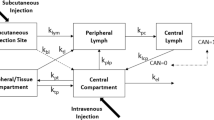Our method for evaluating the time course and intensity of antibiotics and other drugs transport in the predominant direction between the blood and lymph in humans promotes a more objective evaluation of drug circulation mechanisms, which is essential for determining the time of their repeated administration and route of administration. Calculation of the lymph/blood difference coefficient, based on parallel repeated measurements of the drug concentration in the lymph and blood, and of the lymph/blood coefficient provides complete data on the direction and time course of drug transport between the lymph and blood in the predominant direction.
Similar content being viewed by others
References
A. V. Efremov, A. R. Antonov, and T. A. Litvinova, Pat. Fiziol. Eksper. Ter., No. 1, 22–28 (2006).
A. V. Efremov, A. R. Antonov, and Yu. V. Nacharov, Lymphology of Critical States [in Russian], Moscow (2005).
M. D. Mashkovskii, Drugs [in Russian], Moscow (2007).
Yu. A. Petrovich, R. P. Podorozhnaya, S. M. Kichenko, and Z. N. Nazarenko, Patent No. 2242007 of the Russian Federation. A Method for Evaluating the Intensity and Predominant Direction of Substance Transport between the Blood and Nonmineralized Organs (Moscow State Medical Stomatological University. Published 10.04.2007, Bull. No. 10).
I. V. Yarema, I. A. Merzhvinskii, V. U. Shishlo, et al., Khirurgiya, No. 1, 14–16 (1999).
P. Agre, Proc. Am. Thorac. Soc., 3, No. 1, 5–13 (2006).
O. Cirioni, R. Ghiselli, W. Kamysz, et al., Peptides, 29, No. 1, 31–38 (2008).
E. De Bree, A. J. Witkamp, and F. A. Zoetmulder, J. Surg. Oncol., 79, No. 1, 46–61 (2002).
O. Kurukahvecioglu, H. Koksal, O. Gulbahar, et al., Saudi Med. J., 28, No. 12, 1830–1835 (2007).
M. Markman, Drugs, 61, No. 8, 1057–1065 (2001).
O. Ohtani, Y. Ohtani, C. J. Carati, and B. J. Gannon, Arch. Histol. Cytol., 66, No. 3, 261–272 (2003).
M. Oka, C. Iwata, H. I. Suzuki, et al., Blood, 111, No. 9, 4571–4579 (2008).
W. T. Phillips, T. Andrews, H. Liu, et al., Nucl. Med. Biol., 28, No. 4, 435–444 (2001).
Y. Sadzuka, R. Hirama, and T. Sonobe, Toxicol. Lett., 126, No. 2, 83–90 (2002).
E. Strauss and W. R. Caly, Expert Rev. Anti Infect. Ther., 4, No. 2, 249–260 (2006).
Author information
Authors and Affiliations
Corresponding author
Additional information
Translated from Byulleten’ Eksperimental’noi Biologii i Meditsiny, Vol. 147, No. 3, pp. 331–334, March, 2009
Rights and permissions
About this article
Cite this article
Petrovich, Y.A., Yarema, I.V., Kichenko, S.M. et al. Study of Drug Transport between the Blood and Lymph in the Predominant Direction. Bull Exp Biol Med 147, 357–360 (2009). https://doi.org/10.1007/s10517-009-0508-0
Received:
Published:
Issue Date:
DOI: https://doi.org/10.1007/s10517-009-0508-0




